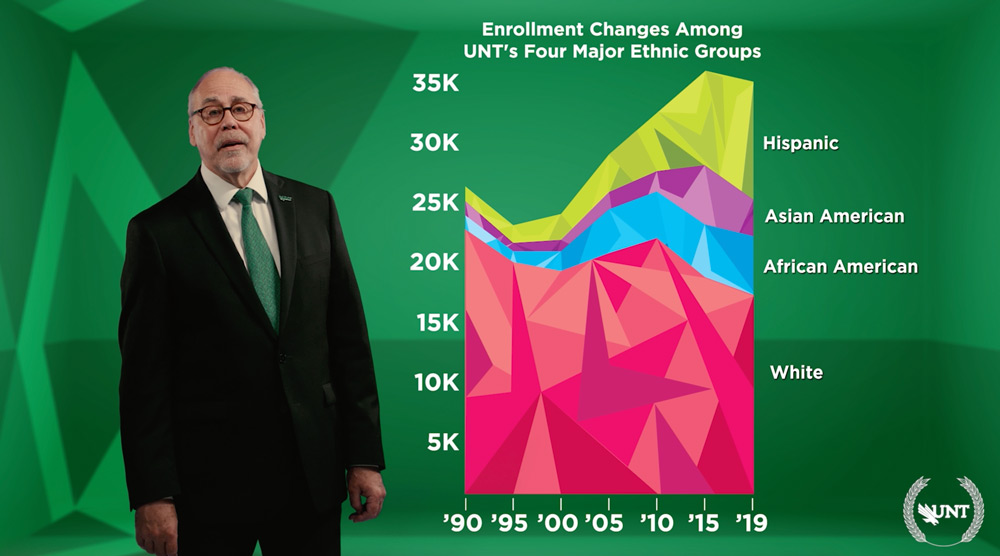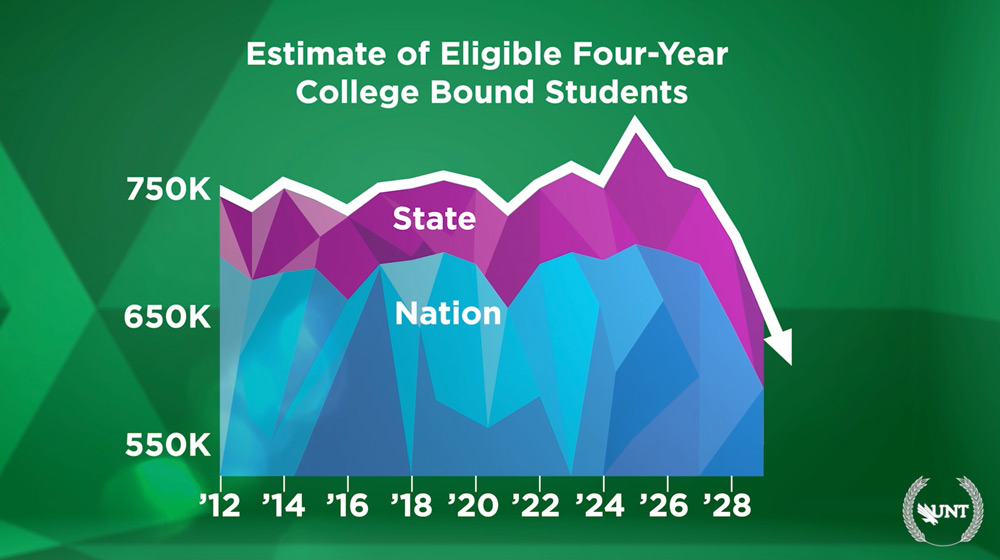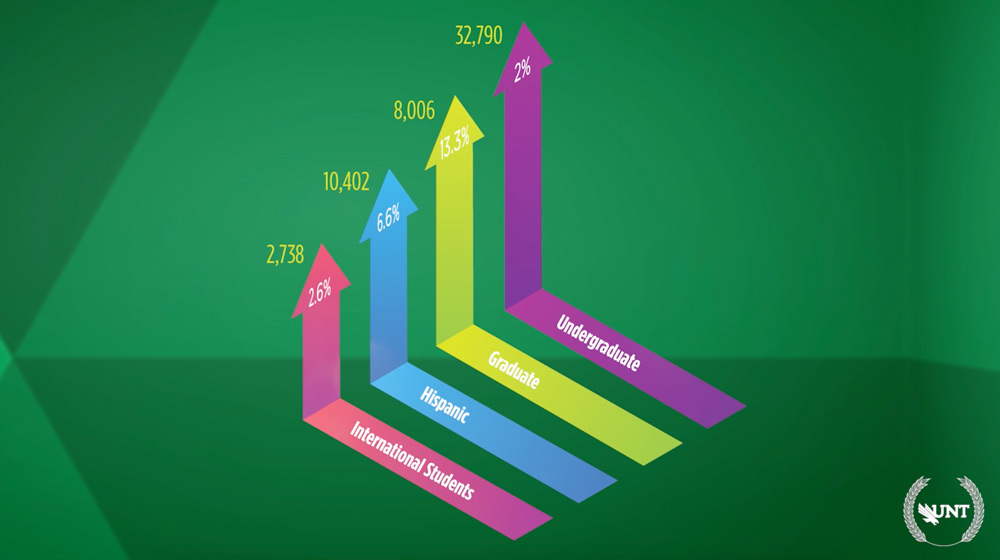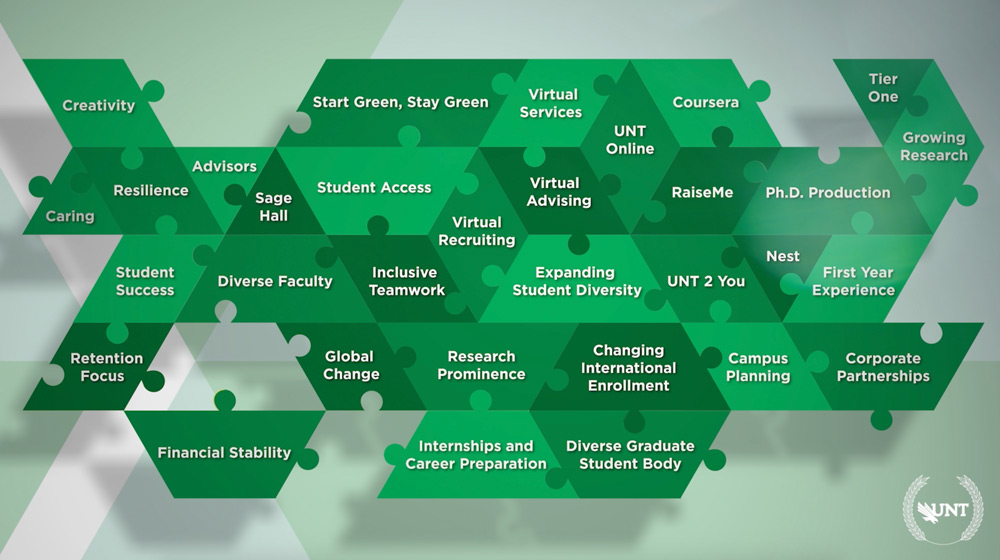Delivered by UNT President Neal Smatresk
Sept. 24, 2020
Watch President Smatresk's State of the University address[BROKEN LINK]
Hi. I'm Neal Smatresk, the President of the University of North Texas, and today is our first ever virtual State of the University. I want to thank you all for taking the time to hear about our progress and how this pandemic has changed how we do business.
You all know it's been a long and challenging year, and in the face of the current pandemic, I wanted to take a moment to recognize your hard work by looking at a few of our achievements. We had a lot to celebrate last year and we made real progress implementing our strategic plans as highlighted in this video.

What a wonderful year it was. Hiring national academy members, increasing the number of programs in the top 100, expanding our enrollment and offering more financial aid and scholarship support, implementing new retention programs, rapidly expanding corporate partnerships, major commitments to become a more diverse and equitable campus, increased research submissions, achieving HSI status and graduating a record number of students. No wonder we have been called one of the top 10 public universities on the rise in the nation and we made big moves in the US News & World Report rankings, moving from 140 to 121 for public institutions this year, leapfrogging many of our competitors.
It's no accident that we have done so well, despite the challenges and uncertainties of the COVID pandemic. We are moving ahead as an institution because of our commitment to our values of creativity, caring and resilience.
If you go over our past State of the University presentations and planning workshops you can see that our planning efforts are coming together. In past years, we worked diligently to implement our plans and as a result you can see that progress.
We achieved financial stability so that we could invest in our strategic plans and our students' success early in my tenure here. We made major commitments to becoming Tier One by expanding our research success and significantly expanding Ph.D. funding to support our research and graduate more Ph.D.s, and that's moved us up in the Carnegie rankings.
We hired a new VP for Digital Strategy and grew our online efforts dramatically to give our students more options for getting their education, like our first in the country launch of our Coursera partnership to provide fully online B.A.A.S. completion degrees at scale, and that's garnered international attention. Just this past year, we produced 169 new high-quality fully online classes. And as the need for going remote and demand has skyrocketed, these classes have served us well.
We're making it easy for our corporate partners and employees to get degrees by providing custom-built and innovative online degree programs, in collaborating with companies like Google, Cinemark, JP Morgan Chase, the Dallas Cowboys and many others.

And in the past few years we have consistently focused our planning efforts on student success through new initiatives like intensifying our retention efforts for all our students through better data tools and launching predictive analytics. We're helping our students and faculty to develop growth mindsets in the classroom through new initiatives like RaiseMe, UNT 2 You, Nest and our First Year Student Experience programs.
We've added more advisors to help our students make better progress and expanded student support services like tutoring and access to services in Sage Hall. And we've added programs like Start Green, Stay Green to help students quickly find critical services and financial support to help limit their debt.

As we look at the changing population demographics in Texas, by limiting tuition increases, we made UNT a more accessible university. And we're creating opportunity for our diverse populations to transform their lives by realizing the dream of a college education.
We intensified our minority recruiting efforts by helping over 3,000 Black and Hispanic students from underrepresented areas with the UNT admissions process and by translating key enrollment webpages and resources into Spanish to better serve Latinx parents and their students.
We have steadily worked on implementing our plans, and each of these is a piece of the puzzle that's building our future. Our plans have also prepared us well for the challenges we are facing during this COVID pandemic. I need to thank you all for coming together and collaborating to help bring those plans to fruition.
Affordability, our changing demographics, and the need for Texas to graduate the next generation of leaders to help guide our economy in the future, all of this means we have to change the way we do business to better meet the needs of our students.

We also have the challenges brought about by COVID, uncertain enrollment, the financial pressures our students face, and the demographic cliff that we see threatening schools across the nation. Fortunately, we have steadily charted a course over the past few years to become an institution known for educational innovation and that innovation and hard work is key to our success during this difficult time. In short, we've shown that we can offer Tier One excellence while expanding access and affordability for our increasingly diverse population.
This year, facing these uncertain times, it's going to be hard to meet some of our goals, but if anything, the pandemic has accelerated our plans to become a next generation institution due to the many COVID heroes who have made this such a successful fall launch. This video celebrates your caring and resilient spirit and the many quiet acts of heroism that have shown your support for our students during this challenging time.

Once again, I thank all of you for pulling together to help our students be successful during this incredibly challenging time. So, let's take a look at where we are now. Fall enrollment is up over 4%, and we have nearly 40,800 students which is up about 1,500 students from last fall, where we also saw a record surge in enrollment. Our record-setting fall enrollment is due to better than expected international enrollment, a 20% increase in graduate enrollment, and the increased enrollment by our returning students - which indicates improving retention and faster graduation times. This is fantastic news!
While enrollment's up, additional expenditures due to COVID, and the continuing loss of auxiliary revenues, about a 5% cut in our state budget, all of those collectively will result in about a $30M to $50M loss of revenues this year. We've had to cover those through budget cuts, CAREs funding, increased enrollment and delays of several major building projects. CAREs ACT, along with GEER and MSI funding, have been incredibly helpful to our students who are struggling financially and by November we will have distributed over $19 million in grants in aid to them.
About 55% of our students are taking classes fully remote or online, while the remaining 45% have a mix of remote, online and face-to-face classes. The face-to-face classes emphasize experiential learning like labs in science and engineering, art and music classes, and classes for freshmen to help them get a strong start here at UNT. These classes are critical so that our students can graduate.
We continue to limit large gatherings, except in Apogee Stadium, where the outdoor seating can accommodate about 25% of our normal capacity with masks and social distancing. Other fall sports have been postponed to spring.
So far it looks like most of our students are respecting our safety rules, and we continue to monitor residence halls and athletics and any places where we know there is an issue, using our rapid testing machines that can test about 200 students and staff members in a day. In addition, we continue to use a statistically sound sampling method to detect COVID surges, in residence halls and other high-risk areas. To date we've seen a modest increase in the number of active cases, on and off campus. Thankfully, the total number of active infections is far lower than we are seeing in many of our other Texas campuses. We have shown that our testing and tracing practices have been effective at limiting the spread of COVID and I hope this trend continues into our spring semester.
We have a mix of telecommuting and on-campus staffing as needed to serve our students, and we're going to continue to offer in person and virtual services. It looks like telecommuting is here to stay, but we recognize the essential need to periodically be on campus together.
While much of this is good news, there are some storm clouds on the horizon. We saw a decline in freshmen and transfer students who were hit hard economically by COVID. It's hard to know right now if this is part of a sea change in college-going behavior, or if this will reverse, but it's a fact we need to attend to now by redesigning how we enroll and retain students.
We also know the number of traditionally college-qualified students is declining, even here in North Texas. If we're going to be successful educating Texans and having a strong economy in years to come, we need to adapt to this new reality by deemphasizing ACTs and SATs, and by doubling down on student success initiatives that speak to our changing demographics as a Minority-Serving Institution, and by creating stronger pathways to employment with our alumni network and corporate partners who are actively trying to diversify their workforce.
With an emphasis on strengthening our diverse culture and creating a more inclusive campus climate, a focus on student success and career preparation with the private sector, creating more access through advanced online and hybrid delivery, and growing access with affordability, we're well on our way to becoming a preeminent next generation university that will be a global leader in educational innovation.
So as we look at what we've done, I hope that you can all see that the pieces of the puzzle are coming together, and as we move our plans forward, we need to be sure that we continue to celebrate what it means to be a caring campus, by addressing these questions:
- How will we perform our mission in the faces of the changes we see in the world?
- As we expand our first generation and Minority-Serving Institution status, how do we promote our students' success and their entry into the job market?
- Will we be able to offer better career development and awareness to meet the needs of private partners and the regional economy?
- How will we retain our students and give them a great experience?
- Can we strategically grow our international and graduate populations?
- How do we build a pipeline for Black and Latinx scholars and researchers?
- Can we create a truly inclusive environment where students, faculty and staff learn to work in diverse groups?
- How do we continue to move deeper into Tier One?
- Will new technology help us better expand access and learning for our students wherever they are?
- How will our campus plans and facility needs change to help us achieve our goals?
- What does remote student recruiting look like and how do we diversify our faculty and staff to reflect our student demographics?

This fall I want to charge our campus leadership with addressing these challenging questions. And as we better understand the impacts and duration of COVID, and the resources that we have available, we'll present our initiatives and strategic investments in January when I will deliver the State of the University, Part 2 to give you an update on our progress, so stay tuned. If we can begin to address these questions and develop initiatives and processes to invest in that expand what we've started, this puzzle will come together and it will form the vision that guides us into the future.
Thank you all so much for everything you do for our students, and for each other. I believe the Mean Green family is stronger than ever and look forward to the year to come knowing that I get to serve one of the most caring communities I've ever seen.